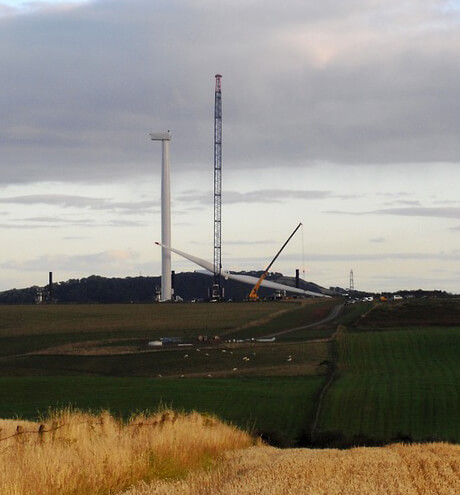The wind industry has gained needed stability thanks to the five-year extension of the Production Tax Credits. However, the extension’s phase-down and 5% safe harbor clause mean developers are hard at work ensuring their wind projects fully qualify for the PTC before year’s end. In the eyes of the IRS, ground need not be broken for a project to have officially started construction. Financial backers, however, require assurances before committing to a new wind investment.

Although according to the IRS, ground doesn’t have to be broken for a wind project to have “started construction” and qualify for the PTC this year, most tax advisors suggest the more work done at a site the better.
So what exactly qualifies as the 5% project minimum? Keith Martin, a Partner with law firm Chadbourne & Parke, offered up one suggestion during AWEA’s recent Wind Energy Finance & Investment Conference in New York. “We are running an ad for an upcoming wind event and on it, it has two dogs digging a hole with a caption that reads, ‘Under Construction,” he laughed. “I hope that counts.” Martin’s point was that not all work at the wind sites qualify.
Martin served as Session Chair at the Finance & Investment Conference for a panel discussion on tax equity. He posed the question to his panel for advice: “I realize those companies that could afford to, started signing PTC component contracts last spring to incur the 5% project costs on the equipment,” he said. “But now smaller companies are digging turbine foundations, putting in roads at project sites, and maybe ordering step-up transformers. How can they ensure financing and enough ‘start of construction’ work on these projects given the current tax equity market?”
“The more work the better,” responded Jack Cargas, Managing Director for Bank of America, Merrill Lynch. “For example, if turbine foundations were started earlier this year, we’d now like to see some of them completed. Of course, onsite work more easily qualifies for the ‘start of construction’ than offsite work, say building a transformer at some factory. But we have been able to get there with transformers in some cases.”
Cargas added that regardless of the exact amount of work completed on a wind project, it is imperative to showcase a detailed, third party record of it that is time-stamped with photographs. “The more detailed the record, the better,” he added.
Next Martin asked about the number of turbine foundations or dug foundation holes required for qualification. “Would 5% be enough or maybe even 10%? Is there a set percentage or threshold?”
“Ten percent is a good rule of thumb,” said Cargas. “And we prefer that the holes are dug by humans, not dogs,” he joked.
Martin laughed and agreed. “We also like to see 10% of the turbine foundations dug to at least 6 -ft. deep, as well as a mile of road to qualify.”

Session Chair and Chadbourne & Parke’s Keith Martin
John Eber, Managing Director of Energy Investments at J.P. Morgan shared a different view on the topic. “I think it’s really important not to consider the least amount of work to be done at a site and to go well beyond what one might regard as sufficient. So, for us, that means a significant amount of the foundations should be built with all the access roads in place, and all necessary equipment at the site.”
He warned that by setting a goal to only meet the minimum requirement, developers are chancing their project’s financing because investors may not want to take on that risk. “You can’t be too careful. There’s way too much value in these PTC to cut corners by risking whether a project qualifies or not. You’re far better off striving for above minimum work at a site.”
“What about current issues or tax equity challenges that have arisen this year — are there many?” Martin asked next.
“No, we don’t have many,” said Eber. “The industry is now relatively mature and we have established relationships with those experienced in the market. I can’t think of an issue that stands out or that is taking an inordinate amount of time or attention. Having said that, most deals do have some unique feature that might lead to a challenge or two.”
“I agree,” stated Daniel Elkort, VP and General Counsel of Pattern Energy Group. He said the main issues tax equity faces is when a new aspect is brought to a deal. “For example, we recently did a deal on a project that had a high fixed transmission charge, and we spent a significant amount of time getting tax equity comfortable with that element mainly because it was new. You have to understand that these transactions are thoroughly reviewed and each detail carefully considered in many different ways. So anything new will take up 60% of your time.”

Jack Cargas, Bank of America, Merrill Lynch
“The risk level in these deals means there isn’t a lot of margin for error,” agreed Eber. “We do feel a substantial amount of pressure to analyze the deals and carefully assess whether or not they are deals we can successfully underwrite.”
Martin then asked about how things will change over the next four years when the PTC begins to phase down. “Do you think the wind market will be able to compete for tax-equity attention in the market, particularly against the solar companies that will still have tax credits?”
“I think there will still be investor appetite for transactions that look for financing of a single, large deployment of capital while spreading the tax capacity over 10 years,” said Cargas.
“Fortunately, we don’t have to deal with that for a few years yet,” added Eber. “We’re focusing on the 100% PTC qualifications for now.” But he pointed out that wind companies that only receive 80 or 60% tax credits with the PTC phase down might face challenges competing with the companies that are still building wind farms with full credits. At a certain point the tax equity becomes expensive.

John Eber, J.P. Morgan
Elkort explained: “As you reduce the PTC, the percentage of your capital that’s coming from tax equity goes down, so you have to use more cash.” That means a company will require deep enough pockets to have that cash on hand. “If you’re going to maintain ever-increasing, competitive projects and keep your IRR’s down, you have to bring in lower-cost capital. So, for example, either John Eber can reduce his prices or he’d have to loosen up the restrictions on leverage to bring in cheaper debt.”
The IRR or internal rate of return is a method of calculating a rate of return, but it does not incorporate other factors such as inflation.
“Is it still the case that tax equity covers about 75% of a typical wind farm today?” Martin asked next.
The panel agreed that percentage is the exception rather than the rule. “It is typically around 50 to 60%,” said Cargas.

Daniel Elkort, Pattern Energy Group
“You can push it up, but if you’re trying to optimize your tax equity — which you should be doing — take the least amount of it possible and keep the pre-tax cash as tight as possible. It shouldn’t be more than at the 50% range for most wind farms,” said Eber.
“And how are today’s wind projects performing overall?” asked Martin.
Eber replied by stating that he has two portfolios. “I have a pre and a post ’08 one. Previously, we weren’t dealing with an industry that is as mature as it is today and we took engineers’ numbers at face value,” he explained. Perhaps not surprisingly, his pre-2008 portfolio performed under expectations by about 10%. “And some deals performed as low as 20 to 25% below expectations. Post ’08, projects performed much more in line with our expectations because the engineers got a little better and we started applying our own haircuts to the initial forecasts.”
Eber admits that there is still a range with some wind projects performing better and worse than anticipated. “But on average, we’re quite pleased with the market.”
To conclude the panel session, Martin asked about new tax equity developments.
“Over the last few months, we’ve been looking a lot at repowering and using tax equity,” shared Eber. By swapping aging turbines with modern, more advanced units, it is possible to revive an old wind farm and increase its productivity and lifespan. “This involves a whole new set of risks. If you do it right, you get PTCs for another 10 years. If not you get zero.”
“We’re also looking at repowering,” Carcas added and said there’s a market out there for it. “Additionally, we are seeing more private equity sponsors than in the past. Private equity has different goals in terms of exit strategies, which can impact tax structures.” The maturity of the industry and low cost of wind has made it an attractive commodity.
“Thank you for your insight, gentlemen,” said Martin as the panel came to a close. “It will be interesting to see what the next few years have in store for the wind industry.”
Filed Under: Construction, Financing, News, Policy




